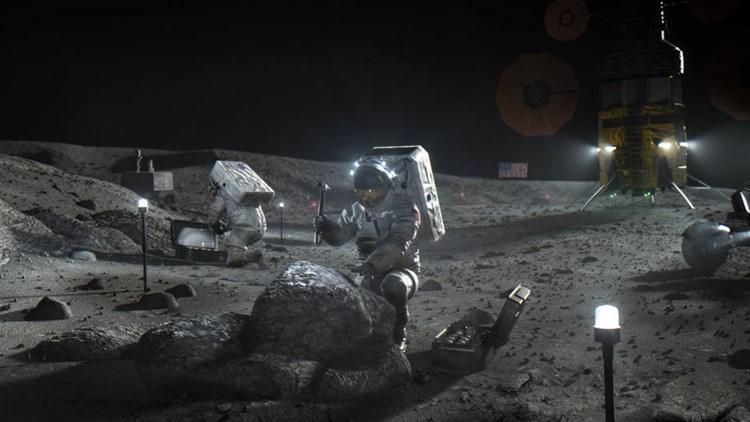ST. PETERSBURG, Fla. — NASA has selected the three private companies to design and develop human landing systems for it's Artemis program: SpaceX, Blue Origin and Dynetics.
These landing systems will be responsible for landing the first woman and the next man on the surface of the moon by 2024, according to NASA.
The last time an American walked on the moon was back in 1972 during the Apollo 17 mission. Astronaut Harrison Schmitt the last U.S. man to step foot on the Moon.
NASA Administrator Jim Bridenstine made the official announcement on Twitter Thursday.
NASA says it is on track for "sustainable human exploration of the Moon for the first time in history."
Helping them will be three companies:
Blue Origin, based out of Washington, is responsible for developing the Integrated Lander Vehicle, which is a three-stage lander that will be launched on its own New Glenn Rocket System and ULA Vulcan launch system.
Then, Alabama-based Dynetics will be responsible for the Dynetics Human Landing System. This is a single structure providing ascent and descent capabilities that will also be launched on the ULA Vulcan launch system.
Finally, the ever-familiar SpaceX, out of California, who is no stranger to NASA programs. They will be developing the Starship, a fully integrated lander that will use the SpaceX Super Heavy Rocket.
NASA says the total combined value of the awarded 10-month contracts is $967 million.
“With these contract awards, America is moving forward with the final step needed to land astronauts on the Moon by 2024, including the incredible moment when we will see the first woman set foot on the lunar surface,” NASA Administrator Jim Bridenstine said. “This is the first time since the Apollo era that NASA has direct funding for a human landing system, and now we have companies on contract to do the work for the Artemis program.”
The program is inspired by NASA's Apollo program and how 50 years ago it proved that it was possible to land humans on the Moon and return them to Earth safely. In Greek mythology, Artemis is the twin sister of Apollo.
RELATED: It’s been 50 years since the Apollo 13 crew safely returned to Earth. Here’s how they did it
“We are on our way,” said Douglas Loverro, NASA’s associate administrator for Human Explorations and Operations Mission Directorate in Washington. “With these awards, we begin an exciting partnership with the best of the industry to accomplish the nation’s goals. We have much work ahead, especially over these next critical 10 months. I have high confidence that working with these teammates, we will succeed.”
And, he is right.
NASA says that over the next 10 months, each commercial partner will refine their concepts and be evaluated, but only one will be chosen by Feb. 2021 to perform initial demonstration missions.
The Artemis program is set to return to the Moon for scientific discovery, economic benefits and inspiration for a new generation, according to NASA.
The agency said it is looking to fine-tune precision landing technologies, develop new mobility capabilities to allow robots and crew to travel greater distances and explore new regions of the Moon.
This announcement comes after NASA cleared the official date for when astronauts will once again launch to space from U.S. soil: May 27.
Doug Hurley and Bob Behnken are set to be the first crew aboard the SpaceX Crew Dragon capsule launching to the ISS atop a Falcon 9 rocket.
RELATED: American astronauts get date to launch from U.S. soil for the first time in almost 10 years
What other people are reading right now:
- Gov. DeSantis says reopening can begin May 4, restaurants can open with restrictions
- JetBlue wants to suspend flights to Tampa
- NASA: Coronavirus has drastically improved Florida's air quality
- 100 bodies found decomposing in rental trucks outside New York funeral home
- Tampa nurse holds the hand of COVID-19 patients as they take their last breaths
- Two Wawa stores close after employees test positive for coronavirus
- Hotlines, websites offer the latest on COVID-19
FREE 10NEWS APP:
►Stay In the Know! Sign up now for the Brightside Blend Newsletter





